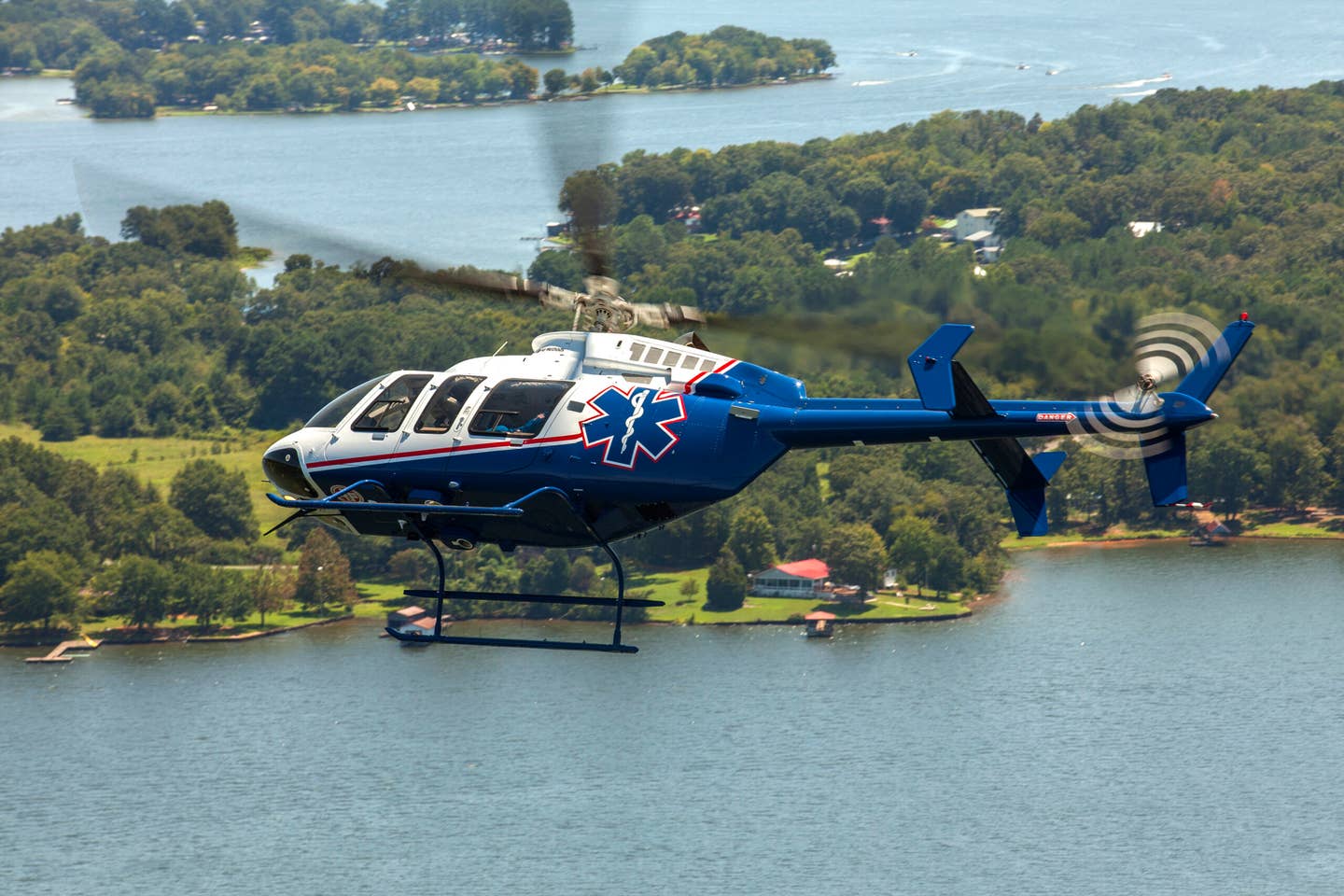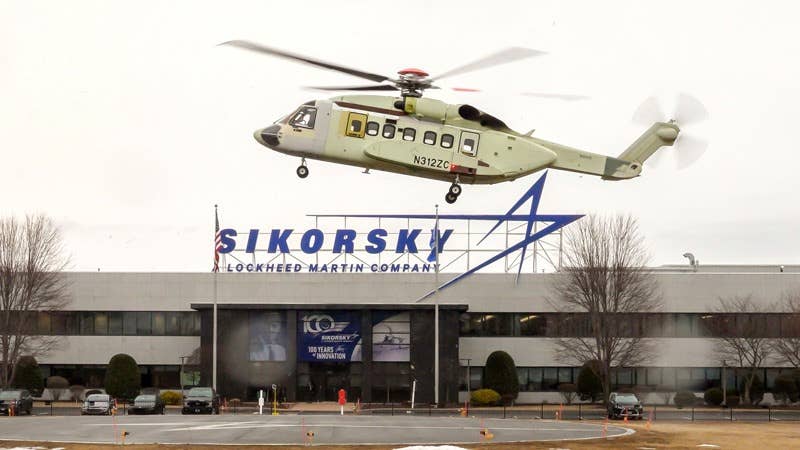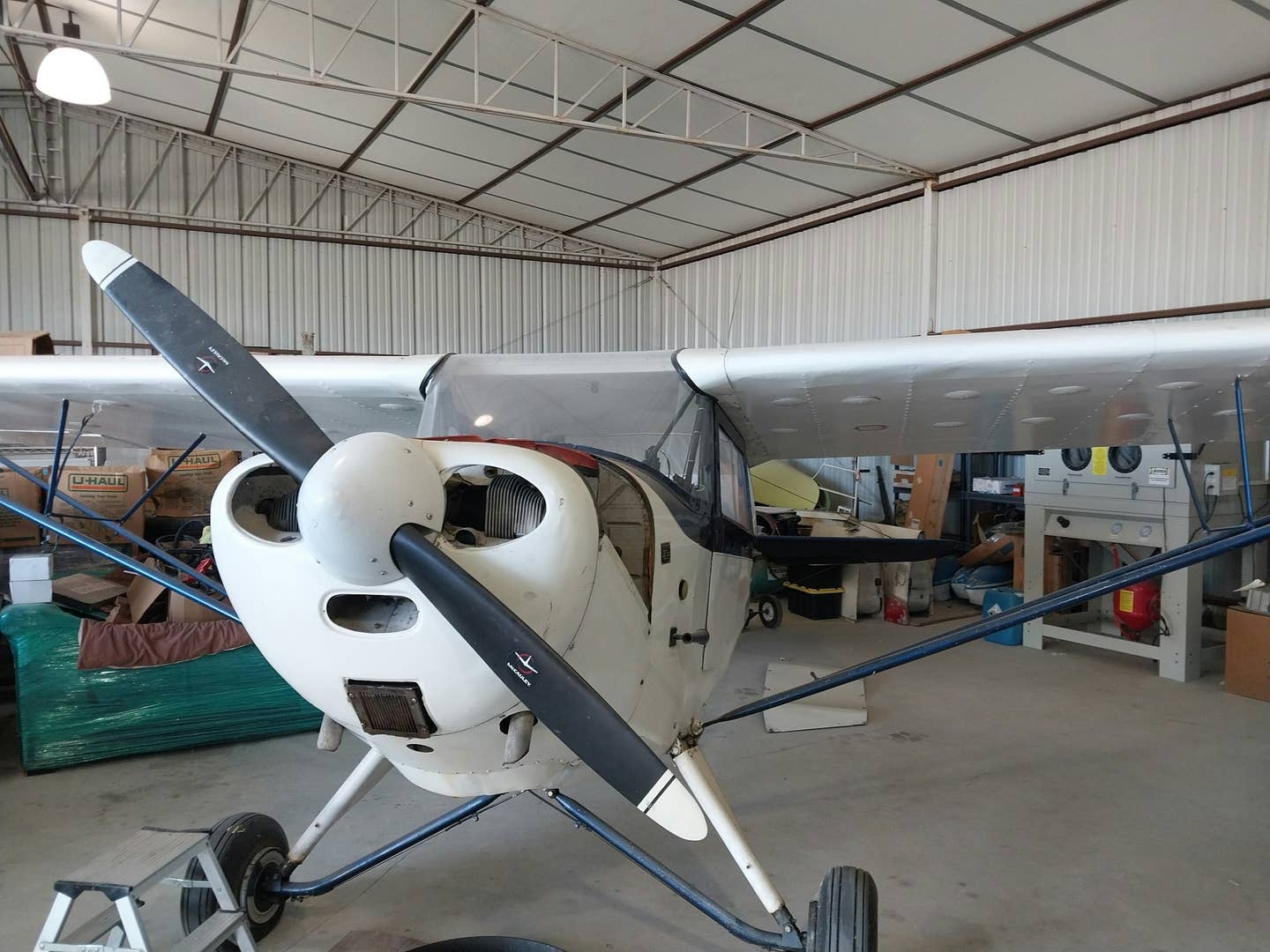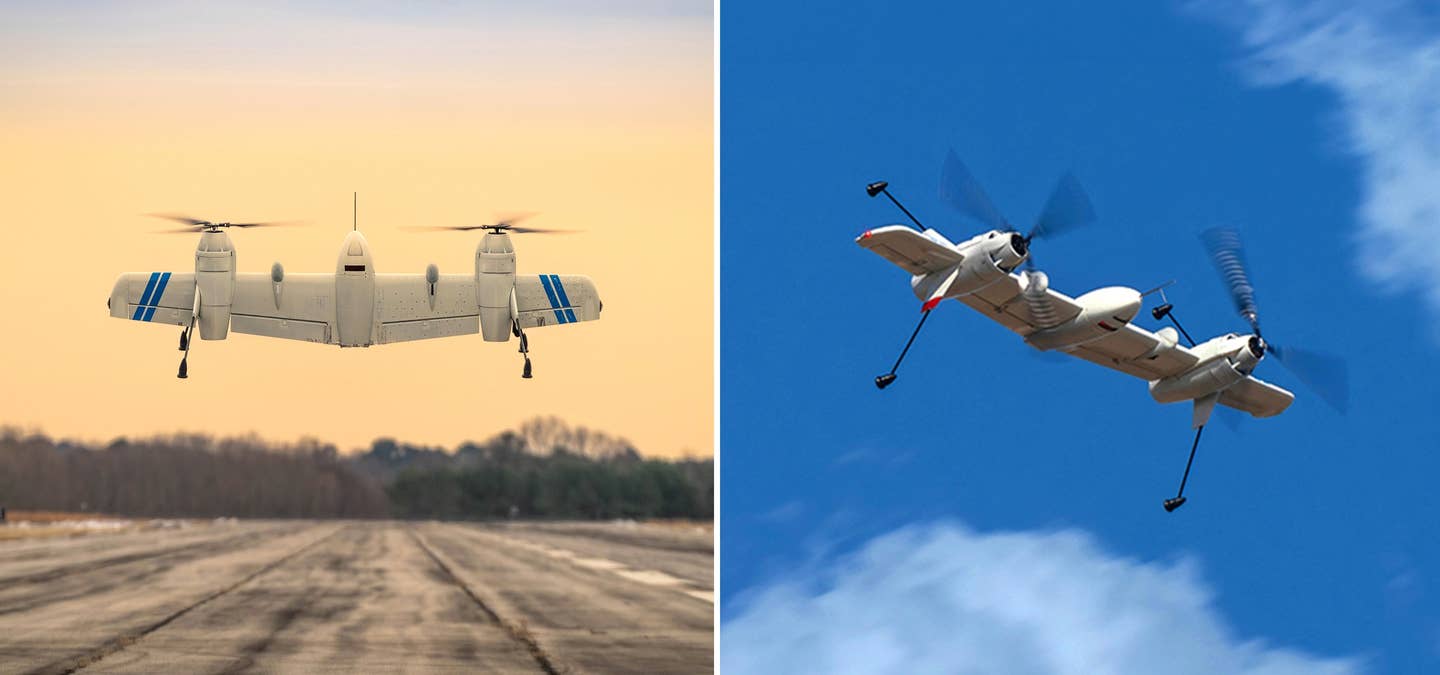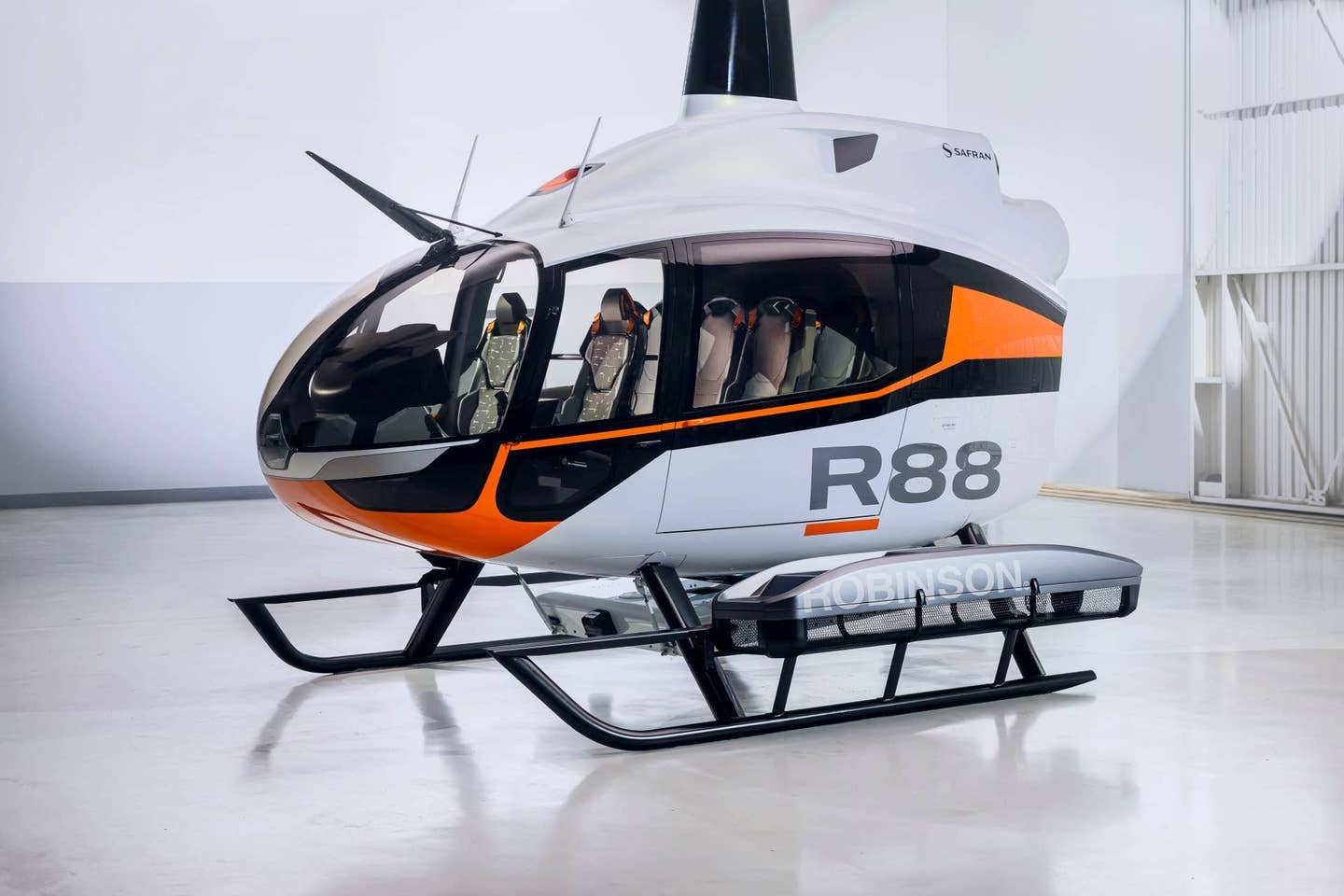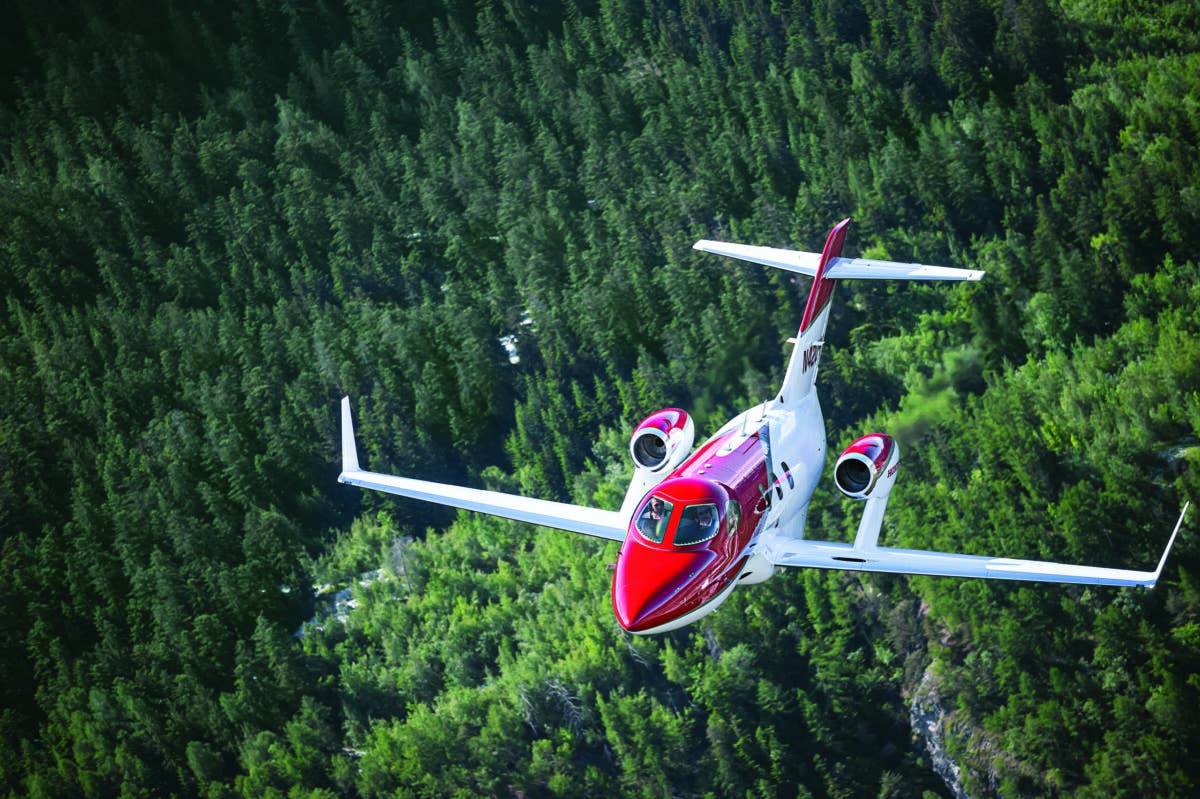
Honda Aircraft’s HA-420 [Courtesy: Honda Aircraft]
When Honda Aircraft Company announced it had received FAA type certification for the HA-420 HondaJet on December 9, the company’s president and CEO, Michimasa Fujino, described the document as “the crystal of sweat and tears.” The sign-off was the culmination of decades of hard work. Fujino became involved in Honda’s aircraft program in 1986. The first drawings of what eventually became the HondaJet were sketched in the early 1990s. The Honda Aircraft branch was established in August 2006, and the first conforming HondaJet flew in December 2010. It is no wonder Fujino refers to the HA-420 as his third daughter.
Beyond the vision of producing aircraft under the world-renowned Honda brand, Fujino chose an over-the-wing mount for the jet engines, claiming the new configuration would provide a quieter cabin and better performance. With the ink now dry on the FAA certification papers, we finally had an opportunity to put this new light twinjet to the test. Could the airplane really do all that Fujino originally envisioned?
The HA-420 HondaJet is powered by two GE Honda Aero Engines HF120 turbofan engines, each producing 1,997 pounds of thrust. The engine pylons atop the wings are constructed of metal. The natural laminar flow wings terminate in sizable winglets. The HondaJet’s fuselage is made of carbon fiber, and its flight deck is built around Garmin’s touchscreen-capable G3000 suite.
Since the HA-420 is Honda Aircraft’s first aircraft offering, the company should be considered a startup. However, walking around the facilities at the Piedmont Triad International Airport (GSO) in Greensboro, North Carolina, it is evident that this is not your typical newcomer. With the backing of the Honda empire, the Honda Aircraft facilities are first-rate, with high-tech security at each entrance, spacious modern offices, and hangars so clean, you could eat off the floors. As with the production of the parent company’s automobiles, sophisticated automation is involved in the production process, which should translate to consistency across the product line.
Adjacent to the factory facility lies the delivery hangar, which has a lazy-Susan-like rotating platform on which the airplane is parked during the delivery process, giving customers of this $4.85 million jet a lavish look at their new airplane while they sign the final paperwork.
The ramp up to deliveries also shows a level of maturity that a regular startup would be hard-pressed to accomplish. By mid-April, less than five months after the FAA inked the certification paperwork, the company had already delivered seven HondaJets.
Not only are the facilities top-notch, a dealer network and an extensive service network with support available 24/7 have already been established. More than 50 maintenance technicians have gone through FlightSafety’s rigorous training program located adjacent to the factory.
With great excitement enhanced by gusty winds and cool, clean crisp North Carolina spring air, I explored N420EX, the first production HondaJet, which has now flown well over 600 hours. If I could summarize the exterior and interior of the airplane, I would refer to it as not only stunning but also highly intelligent. The airplane tells you what to do.
For example, the latches for the external doors are orange on the inside, making it easy to spot one that is not properly closed. I found the latches on the two exterior luggage compartments and cabin airstair door easy to open and close, something pilots who value their fingernails like me will appreciate. In addition to the orange reminders on the access doors and visual inspection windows on the main door, indications on the G3000 will alert the pilot of an improperly shut exterior opening.
A table with a cup holder that folds out on the underside of one of the steps on the airstair door is a clever solution to satisfy a person sitting in the side-facing seat at the entrance.
There is only one external fuel port, making the refueling process quick and simple, but there are four tanks — one in each wing, one in the wing carry-through and one in the area aft of the bulkhead behind the lavatory — providing a total fuel capacity of 2,890 pounds. There is also an optional external lavatory service port, a worthwhile investment to avoid bringing the waste through the luxurious cabin.
One benefit of having the engines mounted on the wings is that the HondaJet has an exceptionally large luggage compartment for an airplane in the light-jet category. The rear compartment is 57 cubic feet and holds up to 400 pounds. The engine is situated adjacent to the luggage compartment, so bulky items may be difficult to load. But there is plenty of space to load large suitcases without trouble.
There is also a 9-cubic-foot cargo area in the nose, capable of carrying up to 100 pounds. Neither of the cargo spaces is pressurized, however, so you may want to keep your toothpaste and any liquid materials inside the cabin.
Due to the center console protruding between the front seats, like it does in many jets, the HondaJet presents a challenge for pilots stepping into the captain and copilot’s seats. To make it easier, Honda Aircraft added a handle in the overhead panel that provides a solid grip while climbing into the seat. It was not difficult for me personally to get in, but I could see how it might be a chore for someone with a limited range of motion.
Once in the seat, multiple adjustments are available. The rudder pedals can be adjusted forward and aft, and the seats move forward, aft, up and down to provide the pilot an opportunity to find the perfect position. There is also an armrest on the right side, which is dampened for smoother action when folded down. The same goes for the other armrests in the airplane.
With my smaller frame, I had the seat at the highest position, a location that provided a stellar view over the sharply angled nose. I felt like a queen on a throne. Despite being high up on my royal perch, I had plenty of headroom, a luxury that is not always guaranteed in light-jet and turboprop cockpits.
The seat also has adjustable lumbar support. After sitting in the cockpit for about two hours and 30 minutes, I was still as comfortable as I would have been in an easy chair. It is evident that this airplane was designed for the owner-operator.
To enable the owner-operator application, the HondaJet is single-pilot certified. With its intelligent systems, the airplane itself can be considered a copilot of sorts.
To streamline the pilot’s flow check, all buttons and switches have a logic that makes it quick and easy to ensure the systems are operating normally. Buttons in the automatic flight control system (AFCS) panel, which is located above the main screens and contains the autopilot functions, are black if normal; buttons on the center console and panel show a white “NORM” for normal indication and are amber in an atypical status. Switches are all in the 12-o’clock position during regular operations. There are also crew-alerting system (CAS) messages on the G3000 screens in the event of failures or during operations that would be considered out of the norm.
The G3000 avionics suite in the HA-420 features three 14.1-inch screens — a PFD for each pilot seat and an MFD in the center — managed through two 5.7-inch GTC 570 touchscreen controllers mounted in the center. The large screens have split views or full views depending on the pilot’s preference for different flight regimes. I scrolled through the built-in checklist with a small wheel on the yoke that allows you to move up and down by rolling the wheel and check off items by pushing on its center.

Before starting the engines, I also went through an automatic systems test. It involves two clicks on the touchscreen and pressing a button called “preflight.” The button activates an automated process that ensures the health of the systems and includes all kinds of bells, whistles and voice alerts, and the activation of the stick shaker and pusher.
The weight and balance calculation is also a breeze. The fuel on board can be automatically synced, and the only task left for the pilot is to add the weight of the cockpit occupant or occupants, passengers and bags in dedicated spots.
With four people on board, totaling just under 600 pounds, and a fuel load of 2,400 pounds, our total load of 10,317 pounds put us more than 300 pounds below the max ramp weight and right in the middle of the CG envelope. Because the wings are mounted so far aft on the fuselage, there is potential for an aft CG scenario for pilots who fly alone with full fuel. However, with the HondaJet’s wide CG envelope, it would be difficult to get the airplane out of forward CG.
The HondaJet’s max ramp weight of 10,680 pounds wouldn’t leave much room for passengers and cargo with a full fuel load. However, the efficiency of the HA-420 allows for good range capabilities, even with limited fuel, as I came to find out.
A flight plan can be quickly entered by typing identifiers on the touchscreens. Once a flight plan is entered, the system automatically figures out the elevation at the destination airport and pushes the data to the pressurization system. With the help of the HondaJet’s smart systems, the entire before-start-up process took just a few minutes, and we were ready to power up the engines.
The start-up is completely managed by full-authority digital engine control (fadec) computers, which are located in the engine pylons. The electronic management takes any fear of a hot start out of the equation. In fact, the engines were incredibly cool after start, showing around 350 degrees Celsius on the systems status screen. In case of a malfunction, the fadec shuts the engine down automatically.
As soon as the engines spooled up, I took my headset off to see if the hype about how the engine location keeps the cabin quiet was really true. Despite high expectations after years of hearing about it, I was completely blown away by the whisper-quiet cockpit. The only reason I could see for using a headset is for ATC communications. However, I certainly didn’t mind putting the plush Bose A20s that I was supplied with for the flight back on my head.
HondaJet’s clever lighting system also takes the workload off the pilot’s hands. All the exterior lights are activated automatically when it makes sense by certain related actions. For example, the taxi light is activated when the emergency brake is disengaged, and the nav lights are engaged between sunset and sunrise. The lights can also be manually turned on or off, should the pilot wish to do so.
After taxiing to Runway 23L at GSO — a process that started out a bit rough because I needed a couple of tries before I could make smooth turns with the electrically controlled, hydraulically activated steer-by-wire system for the nosewheel — my right-seat captain, Tim Frazier, manager of corporate flight operations and demonstration, took the controls to demonstrate a high-performance takeoff and climb.
Frazier held the brakes and pushed the throttle levers to the takeoff position. The acceleration was impressive, and we reached the rotation speed of 112 knots in about 1,400 feet, at which point the airplane joyfully departed the ground. Climbing at an indicated 210 knots, I took over the controls, and we consistently saw more than 4,000 fpm for the first few thousand feet. The budding, bright green deciduous trees covering much of the terrain beneath us quickly disappeared out of view as we broke through a thin overcast layer. We reached the ATC-assigned altitude of 12,000 feet in less than four minutes despite a momentary level off at 5,000 feet.
We continued into the flight levels, and at FL 300 we were still showing a steady 2,000 fpm climb. Once cleared to our requested altitude of FL 430, I twisted the altitude knob on the AFCS panel and noticed that the G3000 wouldn’t allow me to go past that figure on the tape. The clever HA-420 had discreetly pointed out that FL 430 is, in fact, its service ceiling.
Climbing through FL 400, it became evident that we were getting close to the maximum altitude as our rate of climb had decayed to between 100 and 500 fpm, and the gap between barber poles on the speed tape indicating the maximum speed and stall had emerged. But we made it all the way to FL 430 in about 32 minutes despite several ATC-assigned level offs. At no time did the engines complain about the stress of the lengthy high-performance climb. Frazier claimed an unrestricted climb would have allowed us to reach FL 430 in 26 minutes, a number that appears plausible.
No ice was detected by the sensors on either side of the HondaJet’s nose, so the anti-ice system remained with a “NORM” indication. Had there been ice, the smart jet would have activated the anti-ice for the leading edges of the wings and horizontal tail, and boosted the windshield heat to a high setting. The windshield heat, one of several distinguishing features of the HondaJet, with the shark-teethlike pattern at the base of the window, is electric and always active on its low setting when an engine is running.
The only anti-ice system that is not automatically activated is the heated engine inlet system, which is pilot-activated. Bleed air supplies the heat for the leading edges and engine inlets. The tail, on the other hand, has an electromechanical expulsive deicing system (EMEDS).
Had we continued our flight at FL 430, our range ring indicated that we could have made it as far as Cuba that day with a slight tailwind of just 10 knots. However, we decided to stay well within the dotted range ring and opted for a virtual party on the white sandy beaches of Miami instead.
The sophisticated avionics told us we could have landed in Miami in about 1 hour and 45 minutes with 716 pounds left in the tanks. Our fuel load on takeoff was 2,400 pounds, 450 pounds shy of a full load. With the thrust levers set on max continuous thrust (MCT), the fadec gave us about 93 percent N1, a true airspeed of Mach 0.66 (373 knots), and a total fuel burn of about 600 pounds per hour.
As far as our virtual trip was concerned, we could have been sipping mojitos and munching on grilled palomilla steak and plantains much sooner had we leveled off about 10,000 feet lower where performance is optimal, and we would have avoided the degraded climb performance seen near the service ceiling.
While cruising at FL 430, I took my headset off again and took a stroll back to the main cabin area, a 12.1-foot-long space that provides plenty of room for passengers. The club seating arrangement gives ample legroom. I was surprised that my knees were nowhere near those of the 6-foot-1-inch passenger I was facing. Being closer to the engines, I could hear the hum of the HF120s with the lavatory doors open, but with them closed, it was significantly quieter than any of the other light jets I’ve flown in before.
The lav is also far superior to that of many light jets, some of which section the toilet area off with a simple curtain. While the HondaJet’s lavatory is not huge by any stretch, it provides complete privacy, a nice sink with a faucet activated by a motion sensor, and two skylights providing natural light and a unique perspective of the skies above.
It was time to start our descent, and we requested a rapid descent, which the controllers approved after leveling us off for a couple of minutes at FL 330. Just as ATC cleared us for the rapid descent, I realized that we had not verified the top speed at this more efficient altitude. I took a glance at the TAS and noted 406 knots, 14 knots below the published 420 knots, but we were not at max power. Since ATC had been kind enough to clear the airspace below, I pushed the nose over. Frazier claims he has seen true airspeeds as great as 426 knots with a light load.
Targeting the start of the barber pole — 270 knots — on the airspeed tape with the speedbrakes flared out on the tail cone, we initially dropped out of the sky at more than 10,000 fpm. Before we knew it, we were out of the flight levels and in territory where our useful consciousness would have lasted even without supplemental oxygen or the functionality of the superb pressurization system, which had kept the cabin at a benign 8,010 feet at FL 430 with a pressure differential of 8.3 psi. The pressurization system performed perfectly despite the additional stress of the rapid descent. There were only a couple of times when I could sense a minor pop in my inner ears.
Once we were ready to level off at 7,000 feet, the speedbrakes automatically disengaged when I applied power — yet another smart feature. I tried my hand at steep turns, slow flight and a stall, and found the airplane well-balanced and comfortable to hand-fly. The controls are neither sloppy nor stiff. I thought I would miss having an armrest on the left side, but the height of the yoke is such that my arm was in an ergonomic position. I hand-flew much of the time during the flight and felt no arm fatigue.
While we didn’t bring the jet to a full stall, we took it into the barber pole area at just over 100 knots. In its own way of screaming, “We’re too darned slow!” the HondaJet’s stick shaker started vibrating the control column. I lowered the nose and applied full power to make the intelligent airplane relax once again.
We didn’t do any engine-out scenarios in flight because I thought it safer to play with engine failures in FlightSafety’s full-motion simulator, which is realistic enough to enable single-pilot type ratings without any time in the airplane itself. I saw about 1,000 fpm on one engine at 7,000 feet after having climbed to that altitude from 3,000 feet. The book claims the max altitude for single-engine operations with bleed air is 25,000 feet, keeping the airplane above many of the world’s tallest mountain ranges and well above any terrain in North America.
Before making our first approach, I loaded an approach procedure into the G3000 — a quick task with the touchscreens. There are way too many features on the touchscreen controllers to highlight, but one of my favorites was the ability to pinch-zoom, which makes the fine print on the procedure charts easy to read.
After playing around with maneuvers, we pointed the nose toward SIF — an uncontrolled airport called Rockingham County NC Shiloh Airport in the forested flatlands near Stoneville, North Carolina. The gusty winds favored 5,200-foot-long Runway 31. I relinquished the controls, and Frazier brought the jet in for a short field landing. We touched down just beyond the 1,000-foot markers and rolled off the runway on Taxiway B — a distance from touchdown to taxiway of less than 2,000 feet.
Now it was my turn to try my hand at takeoffs and landings. The terrific performance of the HondaJet keeps you on your toes, particularly when closer to the ground. Frazier verbally guided me though a takeoff from SIF and a landing at GSO, targeting 120 knots, 5 knots above the normal approach speed, to keep us out of trouble as the winds were gusting between 11 and 23 knots.
Once beyond the runway threshold, Frazier asked me to keep the nose down to an attitude that, from my royal perch, appeared to make us touch down on the nose. However, Frazier ensured we were in the right attitude, and there was no flare required. Using his guidance, my touchdown was smooth, but, once the trailing-link main gear touched the ground, I didn’t quite hold the nose off enough to ensure a smooth derotation — the process of bringing the nosewheel down. I should have held the yoke back longer.
We did a touch-and-go for a trip around the pattern. In order to stay below 2,500 feet in the pattern, I had to pull the power to idle on the crosswind leg, which at first felt disconcerting but was completely safe. During this approach, I queried Frazier a couple of times about speeds and power settings, to which he responded, “Use your own judgment.” Knowing he would get involved in case I did something unsafe, I guided the airplane through the turbulent air toward the runway. Frazier remained mostly quiet, and I completed another nice touch-and-go.
On the third approach, my right-seat captain was completely silent, and I managed to make a nice approach and landing without any verbal assistance. To use a highly overused but appropriate expression: It was awesome. Taxiing felt comfortable by now, and we did a tight pirouette on the tarmac outside the factory to highlight the airplane’s steer-by-wire system’s capability. We returned 420EX to the ramp technicians completely squawk-free, an impressive feat I have not experienced in any newly certified airplane and a testament to Honda Aircraft’s pursuit of perfection.
With the HondaJet’s stellar speed, pressurization and environmental system, and comfortable and quiet cockpit and cabin, operators and passengers are sure to arrive at their destinations well rested. With the ink barely dry on the FAA certification documents, there are a few items still pending, such as certification for flight into known icing (FIKI) and reduced vertical separation minimums (RVSM). These are expected in the next few months.
The base price for the HA-420 is $4.85 million. However, there are several options, including seat upgrades, cabinets, a second table, cabin management systems, satellite radio, Wi-Fi and more, adding up to as much as $400,000.
At the time of this writing, Honda Aircraft had more than 100 orders for the HondaJet. With seven airplanes delivered, the company expects to ramp up production to three to four jets per month next year, so new customers will have to be patient. But, as the saying goes, good things come to those who wait.
Take a closer look at the HA-420. Photo Gallery

Sign-up for newsletters & special offers!
Get the latest FLYING stories & special offers delivered directly to your inbox

